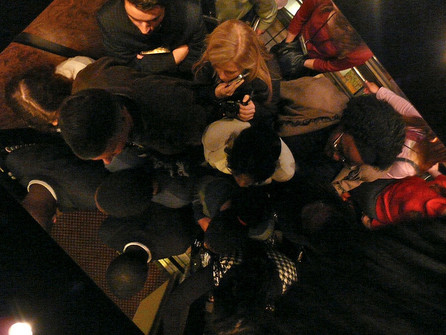 At our escape rooms, our rooms are limited to eight people. For private groups, we hesitantly allow up to ten. While our rooms are larger in size than many other escape rooms in San Diego and can fit far more than 8-10 individuals, there is a limit to how many people can be active at once, no matter what room you're in. Have you ever heard the joke, "How many BLANK does it take to screw in a light bulb?" Well imagine trying to cooperatively screw in a light bulb with 15 people. It's not only close to impossible to involve 15 people in the process, but it would be very unpleasant at the same time. When escape rooms like us build rooms, we build them with a finite number of puzzles, theoretically aimed at a set number of people completing them all within an hour. There is certainly an optimal range. From our research, that sweet spot is 2-8 people. We've had some couples speed through our room and we've had groups of eight limp to the finish, but on average 2-8 is about right. Escape room companies that allow 2-15 people in a room are doing you a disservice. Is it possible to design a single game (series of puzzles) that 2 or 15 people could solve while remaining active? If you've found one, let us know! If the room TRULY had enough puzzles in it to engage 15 people for 60 minutes, then there'd be no way for 2-8 people to come close to getting through it. Or, it's the opposite case. The escape rooms are designed for 2-8 people but companies pack in an extra seven heads for more revenue. In other words, either the rooms are impossible for any small to medium size group or you have escape rooms where half of the participants are standing around doing nothing. We at Quicksand Escape Games have played a lot of escape rooms and haven't found a game that keeps 12-15 people engaged. But imagine one existed. And further imagine that the company hosting the 12-15 person game is popular enough to fill 12-15 slots per session so that the difficulty level is just right each time. Got that image your head? Did you notice that there were clusters of 3 or 4 people working on different things at once? Hardly the collaborative team-building environment you hoped for when you booked the room for ~$400 for the hour. We feel the best solution for hosting a group larger than 10 is to split up into two+ groups. At Quicksand Escape we've hosted corporate groups that have split up and done different experiences simultaneously and we have hosted back to back games of the same experience. Everyone gets to be involved. Everyone has a fun time. When you choose different games, it allows the opportunity for your group to return and swap rooms. When you choose back to back games, you are all able to debrief on the common experience. It allows you to still compare and contrast how you handled the same puzzle. If we packed 15 of you in the room, there would be no common experience besides discomfort. Most participants wouldn't have a clue how the majority of puzzles were solved because they were in the opposite corner trying to remember if they fed their goldfish that morning. Imagine tying to watch a movie with 15 people, except you split into groups of 3, watch different parts of the movie and attempt to piece the story back together afterwards. In conclusion, escape rooms are businesses and making money is key to staying afloat. But as profitable as it may be to squeeze in extra people, it wouldn't be fair to the participants or be true to the experience we intended to deliver. |
Quicksand Escape GamesSan Diego's Favorite Escape Games Archives
May 2023
Categories |
San Diego's Favorite
|
Contact Us
|

 RSS Feed
RSS Feed
